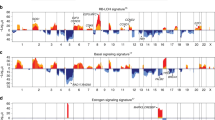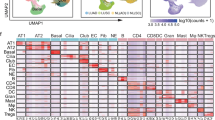Abstract
Amplification and overexpression of putative oncogenes confer growth advantages for tumor development. We used a functional genomic approach that integrated simultaneous genomic and transcript microarray, proteomics, and tissue microarray analyses to directly identify putative oncogenes in lung adenocarcinoma. We first identified 183 genes with increases in both genomic copy number and transcript in six lung adenocarcinoma cell lines. Next, we used two-dimensional polyacrylamide gel electrophoresis and mass spectrometry to identify 42 proteins that were overexpressed in the cancer cells relative to normal cells. Comparing the 183 genes with the 42 proteins, we identified four genes – PRDX1, EEF1A2, CALR, and KCIP-1 – in which elevated protein expression correlated with both increased DNA copy number and increased transcript levels (all r>0.84, two-sided P<0.05). These findings were validated by Southern, Northern, and Western blotting. Specific inhibition of EEF1A2 and KCIP-1 expression with siRNA in the four cell lines tested suppressed proliferation and induced apoptosis. Parallel fluorescence in situ hybridization and immunohistochemical analyses of EEF1A2 and KCIP-1 in tissue microarrays from patients with lung adenocarcinoma showed that gene amplification was associated with high protein expression for both genes and that protein overexpression was related to tumor grade, disease stage, Ki-67 expression, and a shorter survival of patients. The amplification of EEF1A2 and KCIP-1 and the presence of overexpressed protein in tumor samples strongly suggest that these genes could be oncogenes and hence potential targets for diagnosis and therapy in lung adenocarcinoma.
This is a preview of subscription content, access via your institution
Access options
Subscribe to this journal
Receive 50 print issues and online access
$259.00 per year
only $5.18 per issue
Buy this article
- Purchase on Springer Link
- Instant access to full article PDF
Prices may be subject to local taxes which are calculated during checkout


Similar content being viewed by others
References
Anand N, Murthy S, Amann G, Wernick M, Porter LA, Cukier IH et al. (2002). Nat Genet 31: 301–305.
Barrett MT, Scheffer A, Ben-Dor A, Sampas N, Lipson D, Kincaid R et al. (2004). Proc Natl Acad Sci USA 101: 17765–17770.
Chen G, Gharib TG, Huang CC, Taylor JM, Misek DE, Kardia SL et al. (2002). Mol Cell Proteomics 1: 304–313.
Hyman E, Kauraniemi P, Hautaniemi S, Wolf M, Mousses S, Rozenblum E et al. (2002). Cancer Res 62: 6240–6245.
Jiang F, Caraway NP, Li RY, Katz RL . (2005). Oncogene 24: 3409–3418.
Jiang F, Lin F, Price R, Gu J, Medeiros LJ, Zhang HZ et al. (2002). J Mol Diagn 4: 144–149.
Jiang F, Yin Z, Caraway NP, Li R, Katz RL . (2004). Neoplasia (New York) 6: 623–635.
Kim HJ, Chae HZ, Kim YJ, Kim YH, Hwangs TS, Park EM et al. (2003). Cell Biol Toxicol 19: 285–298.
Lee JM . (2003). Reprod Biol Endocrinol 1: 69–73.
Luk C, Tsao MS, Bayani J, Shepherd F, Squire JA . (2001). Cancer Genet Cytogenet 125: 87–99.
Martin B, Paesmans M, Mascaux C, Berghmans T, Lothaire P, Meert AP et al. (2004). Br J Cancer 91: 2018–2225.
Oates J, Edwards C . (2000). Histopathology 36: 341–347.
Pollack JR, Sorlie T, Perou CM, Rees CA, Jeffrey SS, Lonning PE et al. (2002). Proc Natl Acad Sci USA 99: 12963–12968.
Qi W, Liu X, Qiao D, Martinez JD . (2005). Int J Cancer 113: 359–363.
Ross JS, Fletcher JA . (1999). Semin Cancer Biol 9: 125–138.
Shen J, Person MD, Zhu J, Abbruzzese JL, Li D . (2004). Cancer Res 64: 9018–9026.
Thomas D, Guthridge M, Woodcock J, Lopez A . (2005). Curr Top Dev Biol 67: 285–303.
Tonon G, Wong KK, Maulik G, Brennan C, Feng B, Zhang Y et al. (2005). Proc Natl Acad Sci USA 102: 9625–9630.
Wang H, Zhang Z, Li R, Ang KK, Zhang H, Caraway NP et al. (2005). Int J Cancer 116: 285–290.
Acknowledgements
This work was supported by National Institutes of Health Grant CA113707-01, an institutional research grant from The University of Texas MD Anderson Cancer Center, a Developmental Project/Career Development Award from The University of Texas Specialized Programs of Research Excellence in Lung Cancer P50 CA70907, and an M Keck Center for Cancer Gene Therapy Award (all to FJ). We thank Christine F Wogan of the Department of Scientific Publications for editorial review of this manuscript.
Author information
Authors and Affiliations
Corresponding author
Additional information
Supplementary Information accompanies the paper on Oncogene website (http://www.nature.com/onc).
Supplementary information
Rights and permissions
About this article
Cite this article
Li, R., Wang, H., Bekele, B. et al. Identification of putative oncogenes in lung adenocarcinoma by a comprehensive functional genomic approach. Oncogene 25, 2628–2635 (2006). https://doi.org/10.1038/sj.onc.1209289
Received:
Revised:
Accepted:
Published:
Issue Date:
DOI: https://doi.org/10.1038/sj.onc.1209289
Keywords
This article is cited by
-
Potential association of eEF1A dimethylation at lysine 55 in the basal area of Helicobacter pylori-eradicated gastric mucosa with the risk of gastric cancer: a retrospective observational study
BMC Gastroenterology (2022)
-
EEF1A2 interacts with HSP90AB1 to promote lung adenocarcinoma metastasis via enhancing TGF-β/SMAD signalling
British Journal of Cancer (2021)
-
Overall survival prediction of non-small cell lung cancer by integrating microarray and clinical data with deep learning
Scientific Reports (2020)
-
Downregulation of miR-4443 and miR-5195-3p in ovarian cancer tissue contributes to metastasis and tumorigenesis
Archives of Gynecology and Obstetrics (2019)
-
Integrating DNA methylation and microRNA biomarkers in sputum for lung cancer detection
Clinical Epigenetics (2016)



